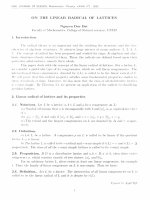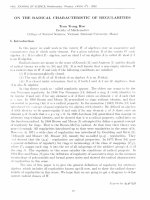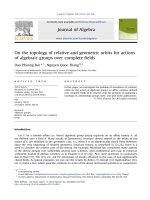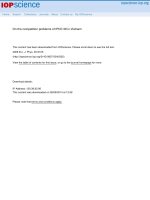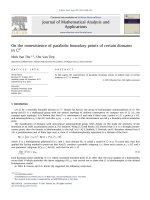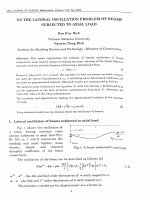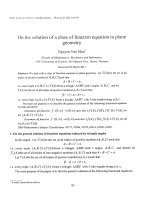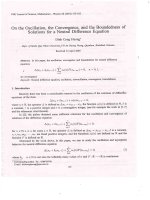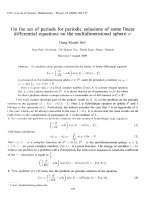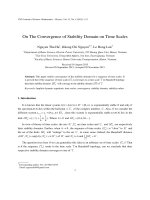DSpace at VNU: On the radical characteristic of regularities
Bạn đang xem bản rút gọn của tài liệu. Xem và tải ngay bản đầy đủ của tài liệu tại đây (2.22 MB, 6 trang )
VNU JOURNAL OF SCIENCE, Mathematics - Physics, t XVIII. n°l - 2002
ON T H E RA DICA L C H A R A C T E R IS T IC OF R E G U L A R IT IE S
T ra n T r o n g H u e
Faculty o f M athem atics
College o f N atural Sciences, Vietnam National University. Hanoi
I. I n t r o d u c t io n
In this paper we shall work in the variety w o f algebra s over an associative and
com m utative ring A which unity elem ent. For a given subclass I Ỉ of th e variety 11 <‘ach
algebra /1 6 R is called Ỉ Ì - algebra, and an ideal I o f an algebra A is called R r ideal if 1
is an //-algebra.
Radical classes are meant ill the sense o f Kurosh [11] and A m itsur [1] and for details
of radical theory we refer to '18] and [19]. It is well known th at a n on -em pty subclass R
is a radical class in w if and only if the following conditions are satisfied.
(i) R is hornornorphically closed.
(ii) T he sum R ( A ) of all /ỉ-id eals of an algebra A is an R r ideal.
(iii) l i is closed under extensions, that is, if both I and A / I are i?- algebra s, then
,4 is also /?- algebra.
In ring theory much so - called regularity appear. T h e oldest one seem s to be the
von Neumann regularity. In 1936 Von N eum ann [14] defined a lin g A (w ith identity) to
he regular if and only if for any elem ent a o f A there ex ists an elem ent X o f -4 such that
a z= (IX(I . In 1950 Brown and M ccoy [6] generalized to rings w ith out identity, and they
siiceeerU'il in proving that it is a radical property. In the m eantim e (1942) Perils [15] had
in trod u m l tli(' concept of quasi-regularity for algebra w ith identity. He defined an algebra
A with identity to be quasi-regular if and only if for any elem ent X of' A there exist an
element ỊỊ of A such th at x + y + x y = 0. In 1945 Jacobson [10] generalized this concept t o
arbitrary ring w ithout identity, and he showed that it is a radical property, called later oil
the Jacobson radical. In 1948 Brown and M ccoy [5j a ttem p ted for define a general concept
of regularity for rings. T h at is the Brown-M cCoy radical. At. th at tim e their theory was
gene nil enough. All regularities introduced up to then were regularities ill the sense of it.
However, in 1971 a w ide class o f regularities was introduced by C ollid ing and Ortiz [8].
McKnight and M usser [12], M usser [13]. nam ely the so-called ( p , q) - regularities. T hey
i;ul showed that th e (p, q) - regularities are radical properties. In 1975 R oos [16] gave
a general definition of regularity for rings is term inology of the class o f m appings { / r_4 } whore F a uiapps each ring A into th e set of all subgroups of the ad d itive group (A . t) of
the ring A. T he regularity in this sense satisfies th e conditions of radical property. In
1981 Hue and Szasa [91 gave the definition of regularity o f associative rings ill the com m on
term inology of polynom ials and formal power series and showed th e radical characteristic
of regularities in this sense.
T he aim of this paper is to give th e general definition of regularity for arbitrary
algebra, which includes all regularities known up till now. and to show th e radical charac
teristic of regularities in this sense. We hope th at we are going to get a diagram to define
correct radical classes of w .
Typeset by -4Ạ/fS-rIteX
10
O n the radical characteristic o f regularities
II. s - r e g u la r it ie s
1. D e f i n i t i o n s
s - n.ifulantf/
L<‘t then? !>(' assigned to ('ncii an algebra .4 belonging to w a mapping s \ which
mapps the direct sum .\ ' ~ -4r|./l,j ... into the algebra A. The class s consisting of all
m appings s,\ will 1><' milt'd a regularity for algebra of \ v if the following condition is
Silt isfi<‘(l.
Fur every /1. I Ì h ]\ and / £ Honi/v'(A ) D ). we have the com m utative diagram
,4 X ...5a- > a
/K1
]f
(»)
« x <--------------- B
S i t
whore
= ( / . / ......).
s - regular alợrhra
An elem ent a of the algebra .4 is called 5-regular if a G 0 - s , \ . An algebra .4 is
said to 1)0 S-regulai if ẦS..\ = A. All ideal / of an algebra A is called 5 - regular if I is an
5-rogular algebra.
2. P r o p e r t i e s
We obviously have the following.
P r o p o s it io n 1. I f tin class s IS a regularity then S /t ( ( 0 .0 ,...) ) = 0 f o r every algebra A
of the class IF.
P r o p o s it io n 2 . The class of the S-re.qular algebras is hom om orphically closed.
Proof. Let B be ail image o f an 5-regular algebra A under the hom omorphism
/ . Now let b
be an arbitrary elem ent of B . Then there exists an elem ent a of A such
that l> = / ( a ) . Sin ce A is an 5-regular algebra there is an elem ent X o f A
such that
s A ( x ) ~ a. B y th e com m utative diagram (a) we have:
h = f(a) = f ( S A(;/•)) = S Bl f * ( x ) ) * S ) - B - .
Therefore' the algebra B is S-rogular.
T h e o r e m 3. I f the class s — { s \ : A ^ —> w4}.tei\ is a regularity then the class of all
S-rcỊỊỉUar algebra IS a radical class in II’ i f and only i f the following condition is satisfied.
If I is an S -rcyular ideal of the algebra A and f o r every element a of A there exists
an (devient Vo f A * such that S a (j:) - a = 0 m od I , then A is a regular algebra.
Proof. A ssum e that the class R of all 5-regular algebras is a radical class. Now
suppose that / is an 5-regular ideal o f an algebra and for every a of A there exists an
element X of A'*' such that S a ( x ) — a = 0 m od / . W e have to show that the algebra
-4 is S-regular. Let us consider th e fact or algebra A / 1 . Take any elem ent ã of A ị I . By
hypothesis there ex ists all elem ent X of A 00 such th at S - A { x ) - a = 0 mod /. So in
Tran 'Trong H u e
\ 2
the factor algebra A / I the equality (I = S a ( x ) holds.
/) : /1 * A / I we have the com m utative diagram
For the natural hom om orphism
A 00
p
(b )
A /I
We have (1 = S a ( x ) = p(S. 4 (x )) = 5 ^ //( p ° ° ( x ) ) . Therefore th e elem ent Ỡ is S regular. T his implies the 5-regularit.v of th e algebra A / I . Since radical classes are closed
under extensions, th e algebra A is 5-regular.
Conversely, assum e th at the 5-regularity satisfies the condition o f th e theorem . We
shall show that the class R of all 5-regular algebras is a radical class. Clearly, the class R
is not empty.
By proposition 2 th e class R is honiom orphically closed. T h e con d ition (i) o f th e
radical property is satisfied.
Now suppose that for an ideal of an algebra A, both / and A / I are /?-algebra.
Since the algebra A / I is .9-regular therefore for every elem ent a o f A there exists an
element 7 of (A /I)'* - such that S a / i { x ) = Ã. By th e com m utative diagram (b) we have
a = ^ //( x ) =
S A/i(p°°{x) ) = p(S>i(x)) = Srf(x). This implies s.,t(;r) - a s 0 mod /.
By the condition of theorem th e algebra /1 is 5-regular. Hence tho class R is closed under
extensions. T he condition (iii) o f th e radical property is satisfied.
By the proposit ion 1 th e zero ideal o f an algebra A is an 5-regular ideal. Hence the
set of the R -ideals o f algebra A is not em pty. Su ppose both I\ and /*2 be R -ideals of the
algebra ,4. By th e second isom orphism theorem we have.
h ± h
/.
h
11 n /2
Since the class R is hom om orphicallv closed and closed under exten sion s, th e above iso
morphism im plies th at /1 + 12 is an /ĩ-algeb ra. By a sim ple induction we can prove that
the sum of any finite number o f I Ỉ - ideals o f th e algebra A is again an /?-ideal. Filially,
we have to show that the sum R ( A ) o f ail fî-ideals o f the algebra A is an 5-regular ideal.
Take any elem ent a of R (A ) . T hen there are thí' R n- ideals / 1 ...... such th at th e ideal
J =
I h- contains the elem ent a. Sine J is an S-regular ideal there is an elem ent JT
of J x such th at s ./( x ) = a. For th e em bedding i j : J —> /?(v4 ) we have th e com m utative
diagram.
O f
./
Therefor th e ideal /Ỉ(A ) is 5-regular. T his com pletes th e proof o f th e theorem .
As the radical criterions o f 5-regularities we have the following assertions.
(c)
ơ n the radical chavuctf'.ristic o f regularities
P r o p o s i t i o n 4. The class of all S -rcỊỊu lar (dọcbras is a radical, class if the following con
dition is satisfied.
F o r arbitrary elements (Ï ill an alqebra A, and X of A™ i f the element S \(:v) - a is
s ' I f (Ịiỉlíỉ I then. iln ỊÉlcmrtì1 a is also s -vcọulav.
Proof. \Y<* are going to si low that th e condition of theorem 3 is valid. Let 1 1><*
call .V-n‘pillar ideal o f an algebra A with the following property: For CVCTV clem ent a of .4
there e x ists an elem ent ./• o f .1 v such that s .t(.r ) - tt = 0 mod I. Therefore1 the* elenirni
s \(.r)
a belongs to the ideal / . Since / is an S-regular ideal so the elem ent S,\(J')
ft
is .S-n'gular. By hypothesis rlie elem ent a is S-ivgular. Thus the» algebra .4 is S’-ro&ular.
T h v con d ition o f Thooivni .*{ is satisfied. T h e proposition is proved.
P r o p o s it i o n 5. 77/f class of all s -re g u la r algebin.s is (I radical (‘lass if the followiiuj
c o n d i t i o n class i f thỉ foil o w n IỈỊ c o n d i t i o n is satisfied.
L i t I be can S - rạ Ịu la r u h a l o f an a lijtb ra A. I f the element a o f t.h.c factor alqcbru
A l is S -ra ju la r. then tlỉỉè (l( lit( 711 a is s -re g u la r in the algebra A.
Proof. A ssum e that I is nil S'-regular ideal o f all algebra A. and for every (’loment
a of /1 then' e x ists nil elem ent r o f A'*' such that s .\(:r ) - a = 0 m od /. Hence ill
I lie factor algobra A / I we have* s ,\{.r ) = a. B y the com m utative diagram (b) we have*
Ti = S a ( j -) = p { S A (. r ) ) = 5 i / , ( / / v (.r)).
Therefore ã is an 5-regular clem ent o f th e algebra A / I . By hypothesis the element (I
is 5-regular ill th e algebra /1. T hus th e algebra A is S-regular. T he condition of Theorem
3 is valid. T he proposition is proved.
I I I . E x a m p le s o f .S -r e g u la r itie s
111 this section wr shall list the ^ r e g u la r itie s which arc' known to us. O ne had proved
thaï th rse regularities are the radical properties in the srnsc of Kurosli <111(1 Am itsur. i.e.
these w ell-known regularities are th e S-regularities satisfying the condition of Theorem
3. Su ppose that u 0 is the variety o f associative algebra. For arbitrary su b sets A' and Y
o f an algebra A we denote -YV = { 5^;I=1 x *y* : x * £ X , y, € Y }. Lot us consider som e
following regularities s k = —> A}.4çvr0 *
1.
.(12— )) =
A ll elem ent a o f an algebra A is said to be regular in the souse o f Neumann [14| if
a € (lAa. Clearly. 5 1-regular coincides w ith the regularity ill the sense of Neum ann.
2 . 6^((<7i,tt2,...) ) = - («-I
T h e right quasi-regularity had been defined by Piîlis [15] and later studied by Baer
|3] and Jacobson [10]. All elem ent a o f ail algebra A is said to be right quasi-regular if
3. S :\ ((a\*U - 2 *. . . ) ) = a -2 +
= ^x’a 2 /+ l a 2 (i+l) + a 2 i-f l ar/,2(i + n
Brow n and M ccoy [5| have introduced the notion o f G-regularity. An elem ent a of
an algebra A is said to 1)0 G-regular if the elem ent a is ill G (a), where
G { a ) = /1(1 + u ) + A ( l -f a ) A
I t is c le a r t o S(»(' I lia i .s,:ỉ- r ( 'g u l a r i t v is G - r e g u la r it y .
Tran Trong H ue
II
4 . s \ ( ( a |.a* 2 , ...)) = d]<v>
T he notion of strongly regular algebra had been introduced by A rm s and Kaplaiiskv
2] and was later studied by others. An algebra A is strongly regular if a 6 a'2A for every
a £ A. It is clear that .^ -regu larity is the sam e as strong regularity.
5.
...)) =
1 Û-2#«I«2H I
D<* La Rose [17 has introduced th e notion o f À-ivgularitv. An (‘l(*ni(‘iit (I of an
algebra .1 is A-regular if a € An A. Clearly. 6v>-regularity is A-regularity.
6.
S j {(a I. a■>■■■■)) = -U -Ỉ(a 1 +
à ị)
D ivinsky [7j has introduced left pseudo-regularity. An elem ent a o f an algebra A
is left pseudo-regular if a -f ba 4- her — 0 for som e clem ent I) of A. It is easy to see that
^ ‘-regularity coincides w ith left pseudo-regularity.
7.
s \ ( ( a J. n-2....) ) = z r I
1a 1aMa 1a'M+ 1
Blair 4| introduced the notion o f /-regularity, which was later stud ied by others.
All element a of 'Mị algebra A is said to be /-reg u la r if a Ç (o'2), where (a ) denotes the
principal ideal o f A generated by a. Blair has show n that an clem ent a ill an algebra A is / regular if and only if there exist elem ents u - i, r, and in, in .4 such as a = X / - Ị u,aVi
8. s 7'\((n [.<!■><...)) — p{<*
where p ( x ) and q {x ) are in the polynom ial ring A'[./:].
The (/M /)-ivgu lw ity was introduced by M cknight and Mussel* [12]. An algebra A
is (/>.p(.r).q(.r) are ill /\ [./•]. It is easy to see th at s^-regularity is (p .q )- regularity ill the sense
of Kckilight and Musser.
T he open problems
P r o b le m 1. F in d a necessary and sufficient condition f o r the s-re g u la rity is hereditary.
P r o b le m 2. Establish some diagrams to define concret radical classes by s-regularities.
R e fe r e n c e s
1. S.A. Am itsur. A general theory of radicals, i. Amer. J. Math., 74 (1 9 5 2 ). 774-786.
2. R.F. Arons and I. Kạplansky. Topological representation of algebras. Trans. Airier.
Math. Sot'.. 6 3 (1948), 457-481.
3. R. Baer. Radical ideals, Amur. J. Math.. 6 5 (1 9 4 3 ). 537 - 568.
I. R.L. Blair. A note on f-regularity in rings. Proc. A m cr. Math.
515.
r>. B.Brown and N.H. Mccov. T h e radical o f a ring. D uke Math.
499.
S oc..6 (1955).
511
15(1948). 495 -
G. B. Brown and N.H. Mccoy. T he m axim al regular ideal o f a ring, Proc. Amer. Math.
Soc .. 1(1950), 165 - 171.
7. N . Divinsky. Pseudo-regularity, Canad. J. Math., 7 (1958), 401 - 410.
Oil the radical characteristic o f regularities
r.
N. I L. Colliding ami A. II. Ortiz. Structure of st'tnipriim’ (]). q) - radicals.
9.
10.
11
12.
i:i
1 I.
15.
l(i.
17.
Is.
19.
I ’at.
./
Math.. 37(1 9 7 1 ), 97 - 9!).
T. T . Mue and F. S /a s /. Oil the radical classes (k'tmniiiLHl by regularities. Acta.
Sri. M ad).. 4 3 ( 1!)M ). i :h - ITO.
N. .Jacobson. Some remarks on one-sided inverses, Pvoc. Amur. Math. Sot'..
1(1950). 352 - :r>:>.
A (Ỉ. Kurosli. Radicals of rings and algebras. Mat. SI)., 3 3 (7 5 ) (1953). 13 20.
.). D. Kcknight and G. L. M usser. Special (p.q) - radicals.
Canad. •/. Math..
2 4 (1 9 7 2 ). 3 8 - 44.
c . L. M ussel-. Linear scm iprim e (p.q) -radical. Pac. ./. Math.. 3 7 (1 9 7 1 ). 749 - 757.
Von N eum ann. On regular rings. Proc. Math. Acad. Sri.. 2 2 (1 9 3 0 ). 7 6 7 - 783.
S. Perl is. A charactrm aU on o f th e radical o f an algebra. Bull. Am er. Math. Sor.,
48(11)42). 128 - 132.
c . R ous. lieyuluritic.s o f rings. D issertation D elft. 1975.
13. D(' La R ose. U rals and radicals. D issertation Delft. 1970.
F A. Szasz. Radiacals of lings. Akadm iai Kind. Budapest 1981.
H. W’i«'•garnit. Radical and sem isiniple classes o f rings. Quern's Papers III Pirn (111(1
A/ipl
M oth..
V o l. 3 7 ( K in g s t o n . 1 9 7 4 ).
TAP C.HI KHOA HOC DHQGHN Toán • Ly t XVIII. n°l - 2002
VỀ Đ Ặ C TRUNc; C A N C Ủ A CÁ C TÍNH CHAT C H ÍN H Q U Y
Trần Trong Huệ
Kltoa Toán - C ơ - Till học
D ili học K h o a học T ự Iiliiên - D H Q C Ì H ù N ộ i
XÓI \ v hì đa lạp các dại sỏ (không nhất thiết kêì hợp) trẻn vành K giao hoán có
đ ơ n v ị. V ớ i m ỗ i đ ạ i s ỏ A th u ộ c i r k ý h iệ u A * là t ổ n g trự c t iế p A „ p l u.sA.ij.... M ỗ i lớ p
các ánh \ ạ s = {5.4 : .4X >
li gọi là một tính chất s - chính quy nếu điều kiện
sau dược thoá mãn:
Đùi với mọi
A , B thuộc IV và / thuộc h o n i K ( A . R ) ta có hộ thức giao hoán
f . s ( - $ i t . f x . trong đó / x = ( / . / . ...)• Phần tứ n cùa đại SC) .1 gọi là S- chính quy nêu
(I ị- Ò.S' (. Đại s ố A aọi là 5 -ch ín h quy nêu 'iS\\ — A. Iđêiiii Ị cua đại số A gọi lit Scliính quy nếu 1 là một đại số S- chính quy.
Trong bài báo này chúng tỏi đã chứng minh được ràng tính chất s - chính quy là
I11 ỘI l í n h c h á t c á n t h e o n g h ĩ a K u r o s h v à A m i t s u r k h i v à c h i k h i đ i ổ u k i ệ n s a u đ ư ợ c t h o i i
m ãn:
Nếu / là một iđêan s - chính quy của đại sô A và đối với mọi a € A tổn tại phần
tử ./• f
sao chos.\(.r) - a = 0 mod I thì A là một đại số S - chính quy.
Từ đặc trưng này ta chứng minh dược hai điéu kiện đủ đổ một tính chất s - chính
quy
là t í n h c h ấ t c ă n .
Trong trườn” hợp 11' là đa tạp các đại sổ kết hợp thì khái niệm
các
k é t q u à c ú a b à ib á o n à y
S-
chính quy và
là s ự t ổ n g q u á t h o á c á c t í n h c h á t c h í n h q u y c ù a c á c
tá c g iá
Von Neum ann, Perlis (cán Jacobson) Brown - McCoy, Kaplansky, De la R ose, Divinsky,
Blair. M aknish - Musser, v.v...
